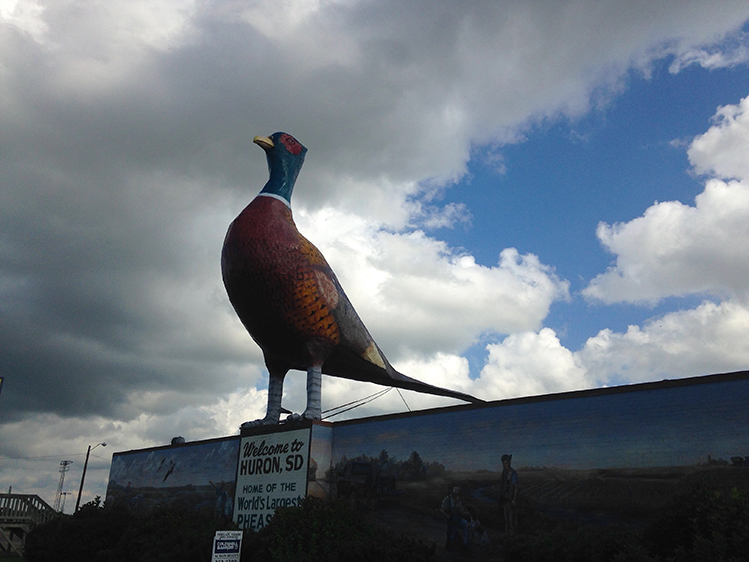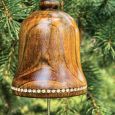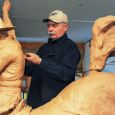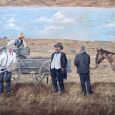The Gift of South Dakota
Subscriptions to South Dakota Magazine make great gifts!
Subscribe today — 1 year (6 issues) is just $29!
A Pheasantless Huron?
Aug 8, 2019
 |
| The World's Largest Pheasant has been a mainstay in Huron for 60 years. Now its future may be in doubt. |
Pheasants Forever is the name of one pheasant-concerned conservation group, but can any pheasant — even the World's Largest Pheasant — truly live forever?
The World’s Largest, a prominent piece of Huron’s skyline since 1959, has sustained serious damage to its structural integrity in its 60 years, and that damage — paired with the fact that the ringneck's perch is not on city-owned property — presents Huron with the possibility of a pheasant-free future.
The city has a lease agreement — which requires some light pheasant maintenance — with the owners of the structure built around the bird. That lease, negotiated 20 years ago with prior owners of the property, expires in 2020. Meanwhile, current ownership wants to sell the property.
Laurie Shelton is President of the Huron Chamber and Visitor's Bureau. She says the phesant’s future is subject to the whims of any potential new owner. "If that owner did not want it there, then we have looked at what the cost would be to build a new pheasant, and then to put that on city-owned property," Shelton says.
However, a move might not be an option. "We have had engineers look at it," Shelton says, "and they do not feel, because of the integrity of the fiberglass, that it would be able to be moved soundly."
Schaun Schnathorst is an engineering technician for the city of Huron. He has repaired and repainted the bird twice in the last eight years. (The last touch-up was just a few weeks ago). He agrees that moving the bird would be a risky endeavor. "When you can lean up against that bird and you push it in — in almost any given area because that's how thin the fiberglass is — it's definitely going to be a challenge to move it," Schnathorst says.
Over the course of 60 years, the fiberglass pheasant has been nested in by hundreds of pigeons, bombarded with UV rays and hailstorms, infiltrated with water, and even taken a lightning strike to the head. "If you look up inside that pheasant you can see daylight," says Schnathorst, adding that some of the original steel mesh frame inside the fiberglass is nonexistent. "So how are you going to strap on to a pheasant and lift it, and not have it cave in with its own weight?"
The Chamber conducted a local survey and found broad support for preserving the pheasant as long as possible. "We like the old pheasant," Shelton says. "If we could work something out as far as the lease, that would probably be the least expensive [option]. It's really kind of a dilemma, and it's not one that's been easy to deal with. We wish that it was on city-owned property because then we wouldn't be having these discussions at all."
"I really think, through social media and how many likes and comments it got after I did a little touch up to it, that the people of Huron want to try to keep it, and keep it in good shape for as long as they possibly can,” Schnathorst says. “Unfortunately, there will probably come a day when it's just run its course. It's not Mount Rushmore. It's not made out of stone."
Huron commissioned sculptor Robert Jacobs of Idaho to create the city's massive fiberglass pheasant in 1959. The ringneck stands 28 feet tall, and measures about 40 feet from beak to tail.
The dedication ceremony, held on the pheasant season opener, starred former governor and pheasant hunting enthusiast Joe Foss, who reportedly fired several blanks from his shotgun at the bird as he departed in his helicopter. Sen. Francis Case and Congressman George McGovern were also on hand.
The initial funding for the project was provided by the local Jaycees, but the owner of the Plains Motel, in front of which the bird stood, had to cough up an outstanding $5,000 at the last minute to keep the disgruntled sculptor from torching his bird.
The World’s Largest Pheasant still makes headlines, and for that reason, you can't count it out. The bird weathered adversity as new owners took over its roost. One such scare in the late 1990s even had other towns giving him the poacher's eye.
He stands for now, barrel-breasted, proud-beaked, with a fresh coat of paint, unfazed by the uncertainty in the ground beneath his feet.
Michael Zimny is the social media engagement specialist for South Dakota Public Broadcasting in Vermillion. He blogs for SDPB and contributes arts columns to the South Dakota Magazine website.









Comments